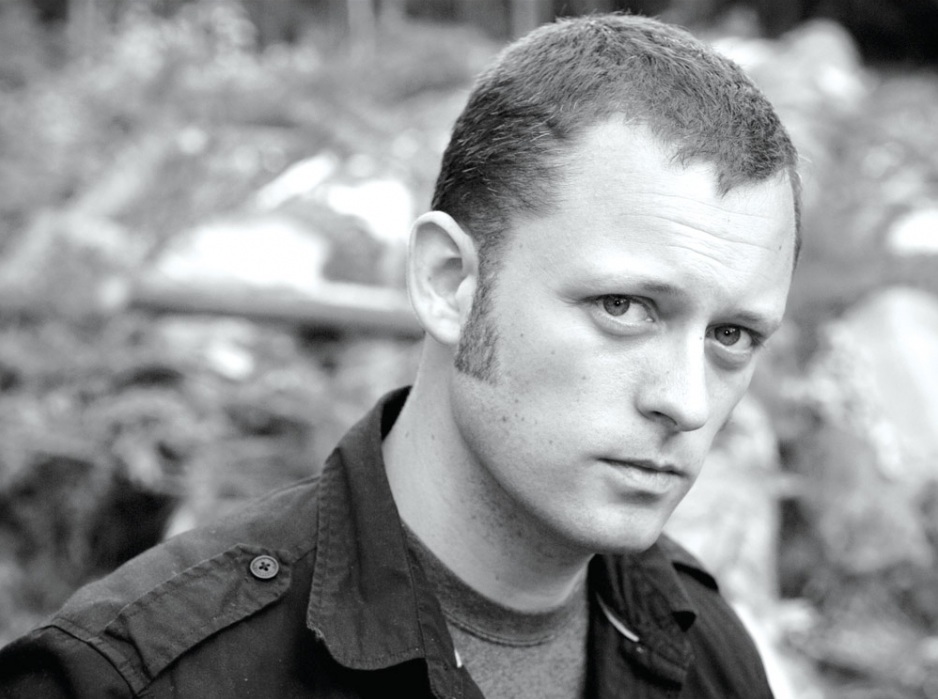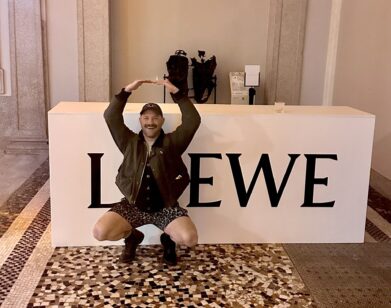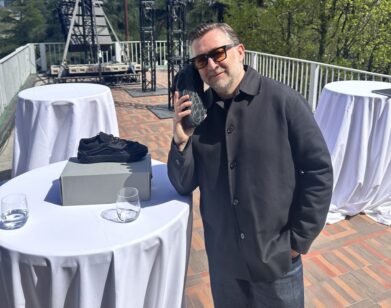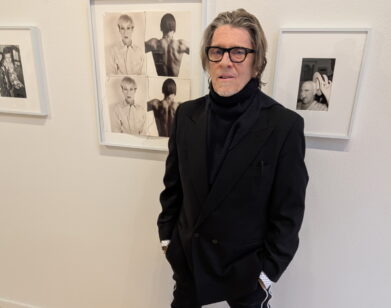The Infectious Benjamin Percy

ABOVE: BENJAMIN PERCY. IMAGE COURTESY OF JENNIFER MAY
In Benjamin Percy’s Orwellian new novel Red Moon, something lurks under the skin and bone of humanity. Claire is a teenage girl, eye-rolling her way through suburban boredom as she sits on the computer at night preparing her college applications—so ready to get far, far away. Patrick is a teenage boy on a plane being shipped across the country to his mom after his father is called back for another tour of duty. When the plane is overcome by a man-turned-beast and Patrick is the only one to survive, the first phase of the lycans’ resistance begins. Werewolves are real, neighbors to you and me. Suburbia is shattered. Claire’s parents are killed. The boundary between the hunted and the hunters is blurred. In a world so close to our own, Benjamin Percy has us asking the ultimate questions: What makes us human? At what cost is it worth protecting? To this end, Red Moon points its sharp-nailed finger at the creature that humanity has become. We chatted with its author about the science of prions, gore-nography, and whether bear meat tastes like chicken.
JENNIFER SKY: In the alternate world of Red Moon, a beast lives hidden in the bodies of human beings. Prions, like those that create mad cow disease, can turn anyone into a werewolf—by birth, by sex, or by bite. How did you figure out the form of transmission?
BENJAMIN PERCY: We’re terrified of germs. If I owned stock, I’d invest in Purel, which oozes from every storefront and counter in the country. Every outbreak of bird or swine flu—or whatever mystery disease of the week—seizes the headlines and sends people into a panic. I wanted to target this: our fear of infection. And I wanted to reinvent the myth in a way that made these lycans, as I call them, not full-moon howlers, but believable horrors.
I think everyone can relate to the werewolf myth—because we’ve all, as a result of alcohol, drugs, exhaustion, rage, gone off the leash and come to regret it later. I appeal to this psychologically—the unleashed id—but with a biological cause; I’m hopefully making possible supernatural circumstances.
SKY: A lot of science is involved. What kind of research did you do?
PERCY: I sat down with researchers at the USDA and at Iowa State University and logged dozens hours of interviews and filled stacks of yellow legal tablets. I wanted to capture the slipper science behind animal-borne pathogens, vaccine development, both the biological process and political maneuvering.
SKY: What was the most surprising thing you found when speaking to these scientists? The grossest? The creepiest?
PERCY: The USDA labs in Ames, Iowa are level-four security clearance. Every nasty thing you can imagine is stored there. Ground zero for the apocalypse. And there’s a day care right across the street.
There is no cure for prions. They are a protein-based disease that, among other things, targets and transforms your brain. The symptoms reveal themselves differently in each host, and you might go months or you might go years before you realize you’re infected. Some say that many of us are already infected with mad cow [disease] and don’t even know it, that many who are diagnosed with dementia might actually be suffering from an infection that is bleeding and rotting their brain.
SKY: There are many mirroring cultural signifiers in this story, such as the upraised fist of the lycans. Was any of the crowdsourcing inspiration pulled from Occupy Wall Street?
PERCY: Sure, but I’m not making any direct comparisons. All through the novel, you’ll see hints of headlines you recognize. I’m trying to target cultural unease, in the same way Frankenstein channels the anxieties of the Industrial Revolution, in the same way that Invasion of the Body Snatchers is a product of the Red Scare.
SKY: Xenophobia is rampant towards the lycans. Their plight seems to reflect our present-day conditions of anti-Muslim fevers, the Israeli state, and civil rights segregation. Was this your intent?
PERCY: My intent is to hold up a mirror with a crack running through it. Everyone will come away from the novel with a different perception of our world. You’ll think you recognize political figures, cultural conflicts, wars, diseases, whatever—but the lines are blurry, and I’m not pointing to any particular thing, or channeling any particular person. It’s a novel that takes a knife to the times.
SKY: There is violence in this book, and there are guns. Yet never does it seem like it is gratuitous or without consequence. There is no romantic notion built around a man or woman and his/her gun. You grew up in the west, did your family have guns?
PERCY: The book is violent at times, and I hope those moments feel earned and consequential and not simply there to titillate. I don’t flinch from darkness, but I’ve always been bothered by what I call gore-nography.
Yes, I grew up with guns. For my 16th birthday, in fact, I received a .357 instead of a car. But there was nothing playful about them; they were tools. My parents went through a back-to-the-land phase. Most of our vegetables and fruits came from our own garden. We had a chicken coop. And my father was a serious hunter—and for many, many years, all of our meat he harvested: venison, elk, bear. Maybe that, eating bear as a child, has something to do with why my voice is so freakishly deep now?
SKY: You do have a wonderfully baritone voice. What is your favorite harvested meat? Did bear taste like chicken?
PERCY: It’s been a few years, but I remember bear tasting… well, rather hairy. The way wet dog smells. My voice dropped when I was 14. And when I was 14, I might have weighed 75 pounds. So you can imagine how strange that must have been: like James Earl Jones speaking through a sock puppet.
SKY: You currently are a teacher of writing and St. Olaf’s College Writer in Residence. How can one teach writing? Do you have any tips?
PERCY: You can’t teach talent, but you can teach people how to read strenuously and mimic the moves of rock-star writers so that they eventually accumulate a toolbox of skills. No different than baseball players or ballerinas or painters or pianists. A writing teacher is a coach. I’m forcing them to watch footage of games repeatedly. I’m adjusting their form. I’m showing them the way colors mix together, the way to play with light and shadow. I’m giving them exercises to elongate a second beat or shorten a third and create a magician’s lilt to their music. I’m yelling at them when they’re being lazy and whispering soothingly when they want to give up and cry and clapping them on the back when they finally pull off a great stunt.
SKY: While this book is very masculine, your main protagonist is a teenage girl. How did you come to this choice?
PERCY: People talk about me as masculine. Because of the way I walk and talk and crank out pull-ups and smell like bacon. But I’m very surprised to hear the book described that way. There is plenty of blow-’em-up action, but it’s balanced out by thoughtful interiority, a love story. And two of the central characters—my favorite characters, badasses, both of them—are women. One young, the other middle-aged: Claire and Miriam. It’s a meaty, epic novel. There are dozens and dozens of named characters (of all ages, ethnicities, professions, political leanings)—it takes place over several years and in different countries—and I wanted it to be as multi-windowed as possible, so that the reader felt like they were seeing all the different ways in to a big haunted house.
SKY: With Red Moon, you have taken literary prose and deftly wound it into a plot-driven, genre-bending thriller. What inspired you to take up the genre torch?
PERCY: I grew up on genre—on Westerns, spy thrillers, sci-fi, fantasy novels, horror novels. Especially horror novels. Every few months, my parents would drive my sister and me over the mountains, from Bend to Portland, to visit the grandparents. And this always included a pilgrimage to the legendary Powell’s Books, where we would stock up on reading until the next trip. The horror section, in the Gold Room, is one of the most magically charged locations of my childhood.
When I took my first creative writing workshop, as an undergrad, I was surprised and affronted that genre was forbidden. Genre, to me, was storytelling, what drew me to the class in the first place. I soon fell in love with literary writers like Sherman Alexie and Alice Munro and Raymond Carver and Flannery O’Connor, but I never fell out of love with genre. In fact, I wrote four failed novels before publishing The Wilding, and three of them had supernatural components.
Red Moon is the book I’ve been hoping to write my whole life. I suppose you could say it’s a hybridized novel in that it has a rip-roaring plot seen through a literary lens.
SKY: What’s your favorite scary movie?
PERCY: Hard call. My favorite horror movie of the last 10 years is The Descent. It’s about a group of women who gather together every year for a wild adventure—this time descending into an uncharted cave. Bad things—very bad things—happen beneath the surface. And it combines wonderfully all sorts of fears (the dark, the tight spot, heights, albino cannibal mutants) while exploring the strained, complicated friendships between the characters.
But my favorite of all time might be Jaws. Hang out with me at the bar sometime, and you’ll probably hear me quoting endlessly from it. The monologue spoken by Robert Shaw in the belly of the ship is the greatest in film history. And the horror of what hides beneath the surface, of the ocean and the men, continues to grip me. I can barely take a bath without thinking of Bruce the shark.
SKY: While we travel great distances and the world undergoes massive change, it seems that by the end of Red Moon there is still room for stories to continue. Can we hope for a possible sequel?
PERCY: I would love to write a sequel. And I’ve already begun to map it out. But I have another novel coming out in the summer of 2014, The Dead Lands, a post-apocalyptic reimagining of the Lewis and Clark saga. And I’ve begun another novel, also a supernatural thriller, to follow it up. And then maybe I’ll tackle the Red Moon sequel. I want to build as many worlds as possible—each a version of ours with a crack running through it—and not be anchored to any of them. But I can see treating Red Moon as Stephen King does the Dark Tower series, returning to it over the years, building stories before, alongside, and after this one.
RED MOON IS OUT IN BOOKSTORES TOMORROW.






